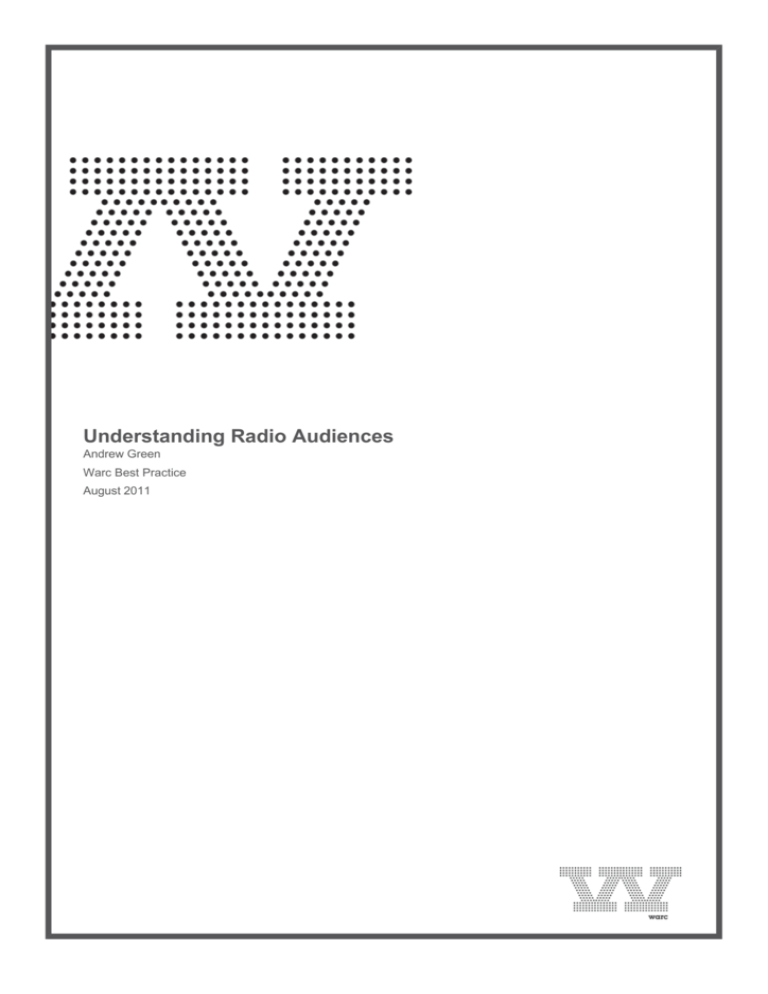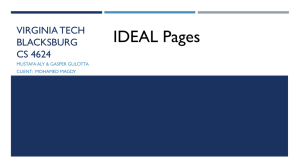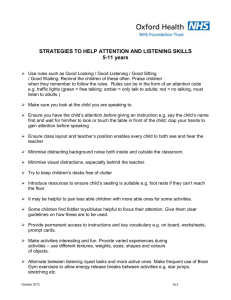
Understanding Radio Audiences
Andrew Green
Warc Best Practice
August 2011
Title:
Author(s):
Source:
Issue:
Understanding Radio Audiences
Andrew Green
Warc Best Practice
August 2011
Understanding Radio Audiences
Andrew Green
Ipsos MediaCT
Go to: EXECUTIVE SUMMARY
Go to: ESSENTIALS
Go to: WHERE TO START
Go to: FUTURE DEVELOPMENTS
Go to: CONCLUSION & CHECKLIST
Go to: FURTHER READING
EXECUTIVE SUMMARY
According to ZenithOptimedia's July 2011 advertising expenditure forecasts1, the radio industry has not made a great deal of
headway with marketers in recent decades. Around US$33 billion will be spent on radio advertising in 2011 – about 7% of
major media adspend globally. This share has never exceeded its high of 9% in 1999 and is predicted to see further gentle
erosion over the coming years.
But if the medium has not always registered with advertisers, it has, like television, the internet and magazines seen an
explosion of outlets. In the United States, for example, the number of stations more than doubled from 2,819 in 1950 to 6,519
in 1970. By 2009 the total had reached 11,2692.
New audio distribution platforms such as the internet, DAB (digital audio broadcasting), the mobile phone and digital satellite
radio have vastly extended the reach of the medium beyond the home, allowing advertisers to target more listening occasions,
places and mindsets, leading many to argue that this will surely increase its share of the consumer's media day3. On the other
hand, of course, as digital technology has advanced other media have been going through the same sorts of changes.
Downloaded from warc.com
2
Radio has long had to battle a perception that it is merely a 'background' medium, despite mountains of research from the
industry pointing to its effectiveness as an advertising medium4. It has also been held back to some extent by what some
would regard as less 'accurate' audience measurement than television media.
ESSENTIALS: The Power of Radio Advertising
Radio plays to several strengths as an advertising medium, evidence for which has been assembled by organisations such as
the Radio Advertising Bureaux in various countries5. These include:
l
The ability to target niche audiences
l
Its role as a 'theatre of the mind' (i.e. listeners build their own visual images as they listen)
l
It is complementary to other media like television (for example, through the theory of 'visual transfer' whereby memorably
television campaigns are recalled on the radio via the use of a similar soundtrack or voiceover)
l
It is mobile (e.g. listening via car radios, mobile phones, television sets and computers) and can accompany many key
consumer activities such as shopping
l
It can be interactive (ability for listeners to talk back via letter/telephone/e-mail/text)
l
It is non-intrusive (strength as background medium)
l
There is some evidence radio is particularly effective at lifting consumer's moods, and can engage emotions at least as
effectively as TV (6RAB UK, RAB US)
l
The medium's small size mean advertisers can more easily establish a dominant share of voice on radio7
WHERE TO START: Measuring radio audiences
Towards the end of the last century, radio became a laboratory for a new kind of audience measurement, not dissimilar to the
revolution that hit the television industry in the 1980s when it moved from a diary/recall to an electronic approach.
First came the MediaWatch, developed in the early 1990s and tested in Switzerland in 19968. This is a wristwatch worn by a
panel of people for a week or more. It is designed to take recordings of a few seconds of sound every minute throughout the
period it is with the panellist, store the data and then send it back to the research company. There, the sounds captured by the
MediaWatch are 'matched' with the known broadcast output of the radio stations being monitored.
Next came the Portable Peoplemeter (PPM), also developed in the early 1990s and first tested by Arbitron in the UK city of
Manchester in 1998 and then in Philadelphia in the United States shortly afterwards9. The PPM is based on embedding an
inaudible code into each radio station's audio output. This code is then detected by a panel of people carrying special pagerlike devices whenever they are within earshot of the signal.
Despite these developments being more than a decade old, as of 2011 only 7 out of the 79 countries with radio audience
measurement services are using one or other of these approaches. The most popular measurement system remains the
listening diary, deployed in 27 countries (two of them – Belgium and the USA – also use the PPM to measure some parts of
the market).
A sample of people are asked to log their daily listening behaviour in a paper diary over the course of a week, indicating
(usually in 15- or 30-minute segments) which stations they listen to and at what times.
Downloaded from warc.com
3
Theoretically, the diaries are completed daily as people go about their business – while memories are fresh. In practice, many
are probably filled in less diligently. This is perhaps the key drawback of the diary approach: the inability of people to
remember every listening occasion, especially as time passes. Short listening occurrences to less frequently tuned stations
may be forgotten, while regular listening to favourite stations is amplified and 'normal' listening behaviour indicated even when
it didn't occur.
There are other limitations. Because it would be difficult to persuade people to keep diaries for long periods, analysis of radio
audience is usually restricted to a week. And though people are asked to recall listening by station, they may not always be
sure which stations they have listened to, especially they had not chosen the particular station themselves (e.g. riding in
somebody else's car or listening to an office radio).
The data also suffers from a lack of granularity. Radio commercials are broadcast at particular times, but diaries only tell us
whether or not people have listened for some part (usually five minutes) of the quarter hour in which the commercial ran.
But the diary has remained an enduringly popular method of measuring audiences partly, of course, because once users get
used to a particular 'currency' of audience data it can be hard to change. One recent development in the technique being
tested in several countries is to ask panellists to fill in the diaries online.
By mid-2011 five countries had introduced online diaries as an option, led by the Netherlands, where around two thirds of
people fill in the diaries this way. In France, Médiamétrie, the audience measurement group, began testing an online diary in 2006. At the time of writing, almost half its respondents complete diary entries online. By mid-2011, the UK and Turkey had
begun offering online diaries to part of their samples, and Belgium offered this as an option.
Online completion offers the potential for greater data processing efficiency advantages and is also a preferred option for
younger audiences. Another key advantage is the ability to track the time gap more accurately between when they listened to
the radio and when they documented this listening in their diaries.
So far, we only have limited data from online diaries, so we must wait for further data to be collected before drawing firm
conclusions about the efficacy of the method.
As was expected, direct comparison of diary and PPM data in the United States has shown that smaller stations increased
their share of overall listening at the expense of larger stations, while less popular dayparts increased in importance versus the
peak 'drive-time' time slot.
Because larger stations tend to have important decision-making power in determining the audience measurement contracts
agreed by the radio industry, these stations may be reluctant to see changes that cause them to 'lose' audience share and
which also reduces the value to them of their morning drive time slots. This may explain partly why the take-up of electronic
measurement has been slow to date. Another very important reason, however, is that electronic measurement tends to be
much more expensive to set up – an important consideration.
The other main method of measuring radio audiences is the telephone Day-After-Recall (DAR) approach, used in 23 countries
(mainly in Europe). People are asked to remember what they listened to on the previous day which, advocates argue, is likely
Downloaded from warc.com
4
to be more accurate than filling in a diary several days after the event. As the telephone call method is cheaper to administer
than a diary, it is also possible to recruit larger samples for any given investment.
Side by side comparisons of the two methodologies carried out in France and elsewhere have shown the broad patterns of
listening to be the same, but that diaries tend to generate higher listening claims overall10.
The key weakness of the telephone approach is that the patterns of listening over time cannot be captured. In addition, it may
be hard for people to identify exactly which stations they have listened to and to remember this on the spot.
A recent innovation in radio audience measurement has been the development by Ipsos (the author's company) of MediaCell.
This is based on asking people to upload a piece of software onto their smartphones which will detect – as the PPM does –
inaudible codes embedded in the broadcast stream of participating stations. Of course not everybody has a smartphone so, in
the early years, part of the research costs will be to provide smartphones to respondents.
Respondents are asked to keep the phones switched on permanently, to carry them all the time and to charge them every day.
In theory, the same people can be tracked for very long periods of time, offering minute-by-minute audience data and a range
of new analyses such as the flow of audiences between stations.
MediaCell is currently being tested in a number of markets.
FUTURE DEVELOPMENTS: Towards the Perfect Radio Survey
Electronic audience measurement faces a number of barriers to adoption. The first is cost. The second is fear of change –
nobody likes to alter an existing audience measurement approach, especially if there is any danger it will show lower
audiences for some or all of the stations paying for the study.
The PPM and MediaCell approaches demand that radio stations embed special codes into their broadcast stream – which
they may refuse to do. So station co-operation is vital to paint a complete picture of the audience.
Perhaps most important of all, the very definition of listening is different with passive, electronic measurement. Instead of
recording listening occasions that people can recall and identify, the new approaches simply measure their presence in the
vicinity of an audio signal, with no information on how intently – if at all – they might be listening.
But all these points must be considered against the very real advantages that passive measurement offers the industry. It
offers:
l
Minute-by-minute audience data
l
Continuous listening data over long periods for very low incremental cost
l
All listening occasions measured, however brief
l
Listening by platform identified – whether in the car, on a mobile phone or via a PC
l
Very low dropout predicted, due to low respondent burden
l
Ability to measure television and other audio-based media
l
Potential for further smartphone applications to be integrated with the radio tracking
Downloaded from warc.com
5
CONCLUSION & CHECKLIST
Like print, radio often suffers in the marketplace from a belief that it is somehow less impactful than television. This is partly to
do with tracking studies that over-represent the power of television, and marketing mix models that fail to take radio properly
into account.
Numerous studies funded by radio industry bodies have been conducted in an attempt to counter these views, contending in
particular that radio's impact disadvantage is in fact relatively small, especially when set against its far greater cost
advantages11. Beyond recall effects – which tend to be the focus of most research studies on radio's comparative impact –
there have also been a number of efforts to examine its positive influence on ROI.
Over the next few years, greater understanding of the medium will come from:
l
Widespread adoption of electronic measurement
l
Greater inclusion of radio in market-mix models
l
Fuller assessments of radio's role in generating ROI
With these measurement and marketing improvements in place, radio could start to make inroads into the appeal of its media
rivals.
FURTHER READING
Articles on Radio Audience Measurement
1. From Prime Time to My Time – Measuring radio audiences
Andrew Green, Warc Exclusive, From Prime Time to My Time, 2010, pp. 60-81
2. From media research to people research? UK audience measurement in 2010
James Aitchison, Warc Exclusive, December 2009
3. Conference notes – Media research: can technology replace interviews?
Richard Windle, International Journal of Market Research, Vol. 51, No. 2, 2009, pp. 271-273
4. Radio and the consumer's mind
James Peacock, Admap, July/August 2007, Issue 485, pp. 16-19
5. And now for something completely different?
P Kennedy, Admap, October 2003.
6. Station to station: Measuring radio audiences with a PPM panel in Québec
P Pellegrini and K Purdye, ESOMAR Radio Conference, June 2005.
7. A full year of audience research with PPM
R Patchen and B Webb, ESOMAR Radio Audience Measurement Conference, June 2003.
8. Put the radiometer on! Will a switch to electronic measurement ruin our currency in Belgium?
D Vancraeynest, ESOMAR WM3 Conference, June 2007.
General Articles on Radio
Downloaded from warc.com
6
9. Radio Spot Length
Jill Peled, ARF – Knowledge at Hand, December 2010
10. Engaging Emotions Through Effective Radio Ads
>www.radioadlab.org.
11. Measuring radio's real ROI
J Peacock, ESOMAR Radio Conference, June 2005.
12. Emotional or informative? Creative or boring? The effectiveness of different types of radio commercial
W Janssens and P De Pelsmacker, International Journal of Advertising Research, Vol. 24, 3, 2005.
13. If I move some of my television budget to radio, will I get a better return?
A Green, Warc Media FAQ, March 2007.
To see all of Warc's articles on Radio, browse the Warc Index here.
Books
Green, Andrew (2009). From Primetime to My Time: Audience Measurement in the Digital Age(Warc)
Websites
www.rab.com/public/ral/committee.cfm
www.radiocentre.org
www.rmb.ca/researchstudies.aspx
www.trb.co.nz
FOOTNOTES & REFERENCES
1. http://www.zenithoptimedia.com/files/media/image/news/Press%20Release%20files/2011/July/Adspend%20forecasts%
20July%202011.pdf
2. Media Dynamics, Inc.(2011). Radio Dimensions 2011
3. Barber, Mark (2007): Time to switch on to Radio 3.0. Admap 480, February 2007.
4. Radio Advertising Effectiveness Laboratory (RAEL). Research Compendium. http://www.rab.com/public/ral/other.cfm
5. See for example http://www.rab.com/public/ral/committee.cfm
6. Radio: the Emotional Multiplier, RAB UK; Engaging Emotions through Effective Radio Ads, RAB US
7. Radio Planning Strategies, Radio Marketing Bureau, Canada
8. Steinmann, Matthias (1997). Radiocontrol. A New Era in Radio Usage Research. ESOMAR Radio Research Symposium,
Warsaw, July 1997.
9. Patchen, Robert and Webb, Beth (2003). A Full Year of Audience Research with PPM. ESOMAR Radio Audience
Measurement Conference, June 2003
10. Saal, Rene, de Saint Roman, Arnaud and Le Moal, Odile (1995). Diary vs. Recall. Mediametrie Complementary
Approaches for Measuring Radio Audiences. ESOMAR Radio Research Symposium, July 2005
Downloaded from warc.com
7
11. Ferris, Jackie and Charlebois, Owen (1999) Assessing radio advertising effectiveness: a comparison of radio and TV
advertising recall. ESOMAR Radio on the World Stage conference, June 1999.
ABOUT THE AUTHOR
Andrew Green is Chief Marketing Officer at Ipsos MediaCT and the author of the book, From Prime to My Time: Audience
Measurement in the Digital Age. He has held senior research positions at Zenith Optimedia, Billetts, OMD, Nielsen and Carat.
Warc publishes Best Practice papers on all areas of marketing. If you are not a Warc subscriber and would like to
see the full series, you can take a trial at www.warc.com/TrialIPSOS.
© Copyright Warc 2011
Warc Ltd.
85 Newman Street, London, United Kingdom, W1T 3EX
Tel: +44 (0)20 7467 8100, Fax: +(0)20 7467 8101
www.warc.com
All rights reserved including database rights. This electronic file is for the personal use of authorised users based at the subscribing company's office location. It may not be reproduced, posted on intranets, extranets
or the internet, e-mailed, archived or shared electronically either within the purchaser’s organisation or externally without express written permission from Warc.
Downloaded from warc.com
8







